NRSG263: Critical Analysis of Restraint and Seclusion in Mental Health
VerifiedAdded on 2022/09/15
|11
|3132
|16
Report
AI Summary
This report critically analyzes the impact of restraint and seclusion on mental health consumers and healthcare professionals. It explores the negative consequences of these practices, including physical and emotional harm, increased risk of suicide, and erosion of trust. The report highlights the role of registered nurses in mitigating these effects through patient-centered care, ethical considerations, and collaboration with consumers. It examines the impact of seclusion and restraint on the well-being of both patients and healthcare providers. The report also discusses the National Mental Health Commission's initiatives, the Safewards model, and strategies to reduce restraint and seclusion, emphasizing the importance of a safe and supportive environment for recovery. Various government frameworks and nursing interventions are discussed to minimize the use of restrictive practices and promote a recovery-oriented approach to mental health care.
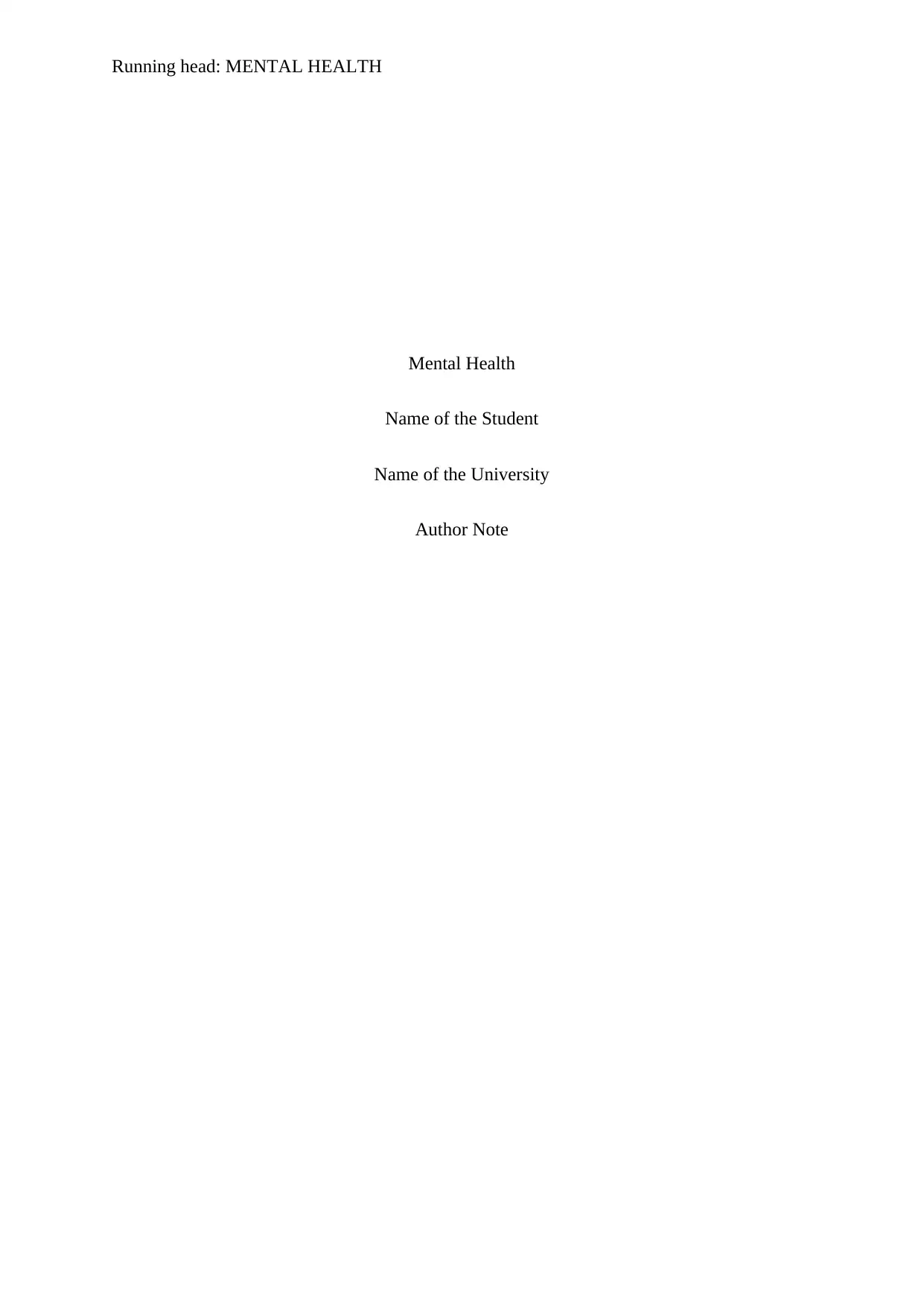
Running head: MENTAL HEALTH
Mental Health
Name of the Student
Name of the University
Author Note
Mental Health
Name of the Student
Name of the University
Author Note
Paraphrase This Document
Need a fresh take? Get an instant paraphrase of this document with our AI Paraphraser
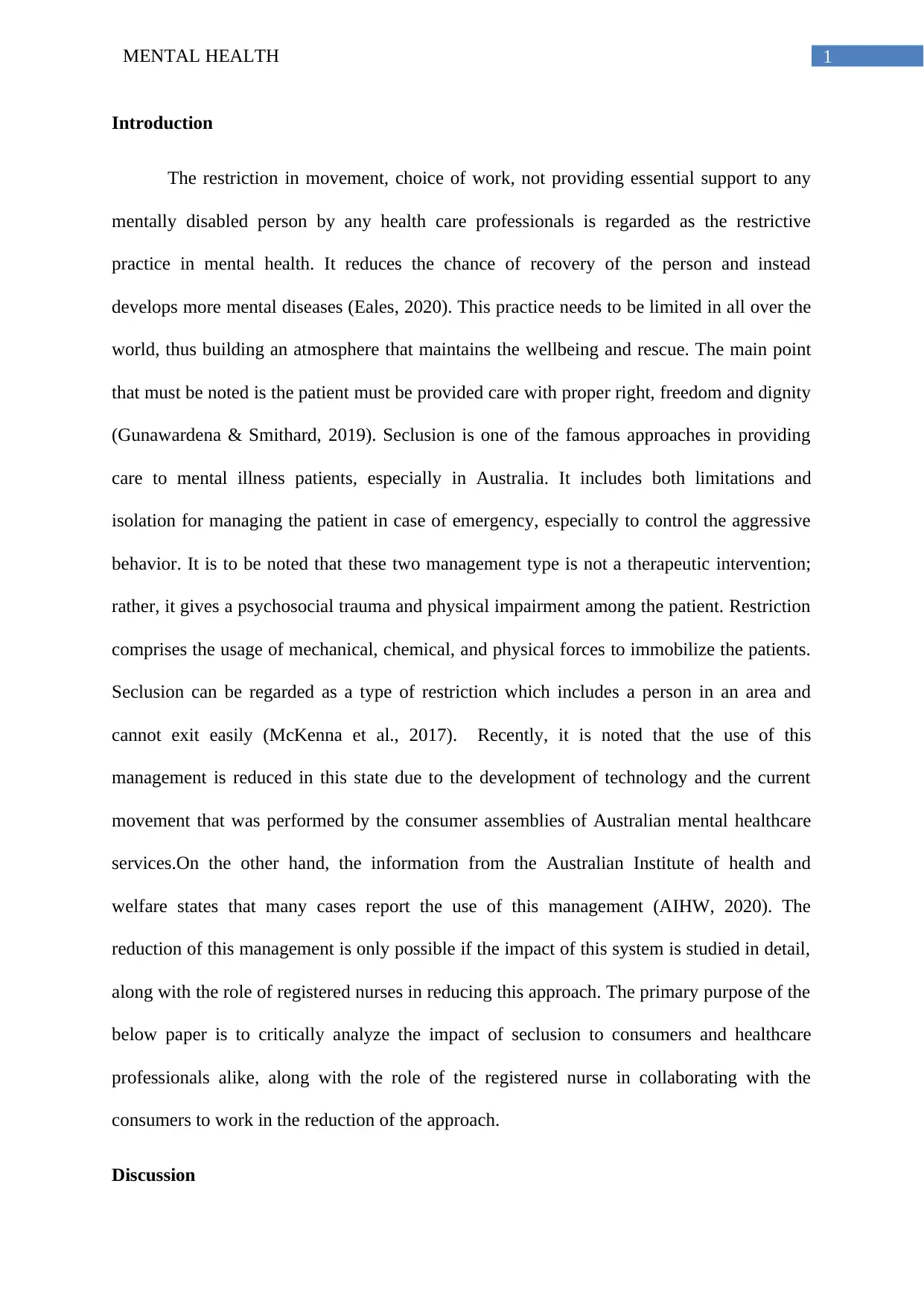
1MENTAL HEALTH
Introduction
The restriction in movement, choice of work, not providing essential support to any
mentally disabled person by any health care professionals is regarded as the restrictive
practice in mental health. It reduces the chance of recovery of the person and instead
develops more mental diseases (Eales, 2020). This practice needs to be limited in all over the
world, thus building an atmosphere that maintains the wellbeing and rescue. The main point
that must be noted is the patient must be provided care with proper right, freedom and dignity
(Gunawardena & Smithard, 2019). Seclusion is one of the famous approaches in providing
care to mental illness patients, especially in Australia. It includes both limitations and
isolation for managing the patient in case of emergency, especially to control the aggressive
behavior. It is to be noted that these two management type is not a therapeutic intervention;
rather, it gives a psychosocial trauma and physical impairment among the patient. Restriction
comprises the usage of mechanical, chemical, and physical forces to immobilize the patients.
Seclusion can be regarded as a type of restriction which includes a person in an area and
cannot exit easily (McKenna et al., 2017). Recently, it is noted that the use of this
management is reduced in this state due to the development of technology and the current
movement that was performed by the consumer assemblies of Australian mental healthcare
services.On the other hand, the information from the Australian Institute of health and
welfare states that many cases report the use of this management (AIHW, 2020). The
reduction of this management is only possible if the impact of this system is studied in detail,
along with the role of registered nurses in reducing this approach. The primary purpose of the
below paper is to critically analyze the impact of seclusion to consumers and healthcare
professionals alike, along with the role of the registered nurse in collaborating with the
consumers to work in the reduction of the approach.
Discussion
Introduction
The restriction in movement, choice of work, not providing essential support to any
mentally disabled person by any health care professionals is regarded as the restrictive
practice in mental health. It reduces the chance of recovery of the person and instead
develops more mental diseases (Eales, 2020). This practice needs to be limited in all over the
world, thus building an atmosphere that maintains the wellbeing and rescue. The main point
that must be noted is the patient must be provided care with proper right, freedom and dignity
(Gunawardena & Smithard, 2019). Seclusion is one of the famous approaches in providing
care to mental illness patients, especially in Australia. It includes both limitations and
isolation for managing the patient in case of emergency, especially to control the aggressive
behavior. It is to be noted that these two management type is not a therapeutic intervention;
rather, it gives a psychosocial trauma and physical impairment among the patient. Restriction
comprises the usage of mechanical, chemical, and physical forces to immobilize the patients.
Seclusion can be regarded as a type of restriction which includes a person in an area and
cannot exit easily (McKenna et al., 2017). Recently, it is noted that the use of this
management is reduced in this state due to the development of technology and the current
movement that was performed by the consumer assemblies of Australian mental healthcare
services.On the other hand, the information from the Australian Institute of health and
welfare states that many cases report the use of this management (AIHW, 2020). The
reduction of this management is only possible if the impact of this system is studied in detail,
along with the role of registered nurses in reducing this approach. The primary purpose of the
below paper is to critically analyze the impact of seclusion to consumers and healthcare
professionals alike, along with the role of the registered nurse in collaborating with the
consumers to work in the reduction of the approach.
Discussion
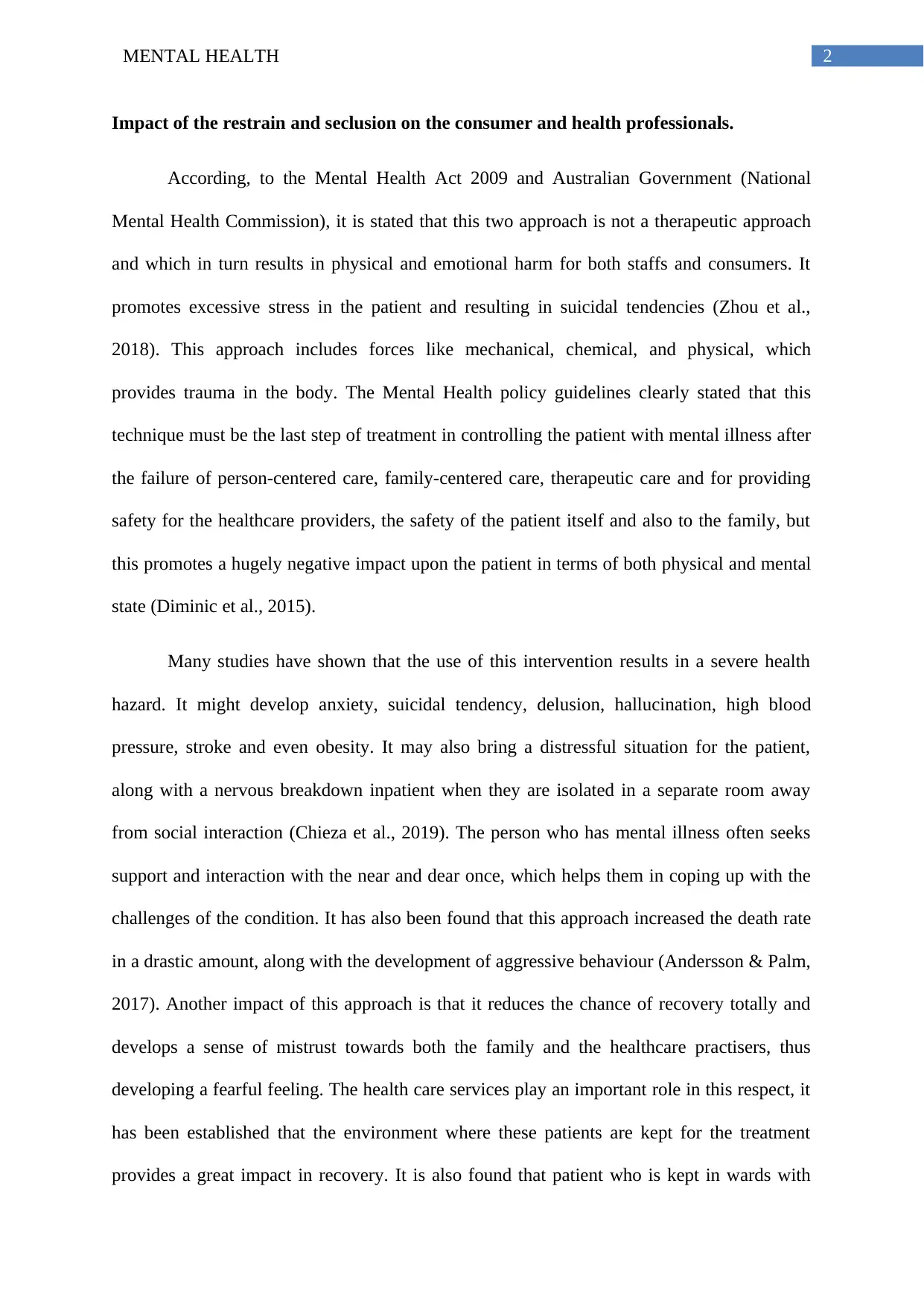
2MENTAL HEALTH
Impact of the restrain and seclusion on the consumer and health professionals.
According, to the Mental Health Act 2009 and Australian Government (National
Mental Health Commission), it is stated that this two approach is not a therapeutic approach
and which in turn results in physical and emotional harm for both staffs and consumers. It
promotes excessive stress in the patient and resulting in suicidal tendencies (Zhou et al.,
2018). This approach includes forces like mechanical, chemical, and physical, which
provides trauma in the body. The Mental Health policy guidelines clearly stated that this
technique must be the last step of treatment in controlling the patient with mental illness after
the failure of person-centered care, family-centered care, therapeutic care and for providing
safety for the healthcare providers, the safety of the patient itself and also to the family, but
this promotes a hugely negative impact upon the patient in terms of both physical and mental
state (Diminic et al., 2015).
Many studies have shown that the use of this intervention results in a severe health
hazard. It might develop anxiety, suicidal tendency, delusion, hallucination, high blood
pressure, stroke and even obesity. It may also bring a distressful situation for the patient,
along with a nervous breakdown inpatient when they are isolated in a separate room away
from social interaction (Chieza et al., 2019). The person who has mental illness often seeks
support and interaction with the near and dear once, which helps them in coping up with the
challenges of the condition. It has also been found that this approach increased the death rate
in a drastic amount, along with the development of aggressive behaviour (Andersson & Palm,
2017). Another impact of this approach is that it reduces the chance of recovery totally and
develops a sense of mistrust towards both the family and the healthcare practisers, thus
developing a fearful feeling. The health care services play an important role in this respect, it
has been established that the environment where these patients are kept for the treatment
provides a great impact in recovery. It is also found that patient who is kept in wards with
Impact of the restrain and seclusion on the consumer and health professionals.
According, to the Mental Health Act 2009 and Australian Government (National
Mental Health Commission), it is stated that this two approach is not a therapeutic approach
and which in turn results in physical and emotional harm for both staffs and consumers. It
promotes excessive stress in the patient and resulting in suicidal tendencies (Zhou et al.,
2018). This approach includes forces like mechanical, chemical, and physical, which
provides trauma in the body. The Mental Health policy guidelines clearly stated that this
technique must be the last step of treatment in controlling the patient with mental illness after
the failure of person-centered care, family-centered care, therapeutic care and for providing
safety for the healthcare providers, the safety of the patient itself and also to the family, but
this promotes a hugely negative impact upon the patient in terms of both physical and mental
state (Diminic et al., 2015).
Many studies have shown that the use of this intervention results in a severe health
hazard. It might develop anxiety, suicidal tendency, delusion, hallucination, high blood
pressure, stroke and even obesity. It may also bring a distressful situation for the patient,
along with a nervous breakdown inpatient when they are isolated in a separate room away
from social interaction (Chieza et al., 2019). The person who has mental illness often seeks
support and interaction with the near and dear once, which helps them in coping up with the
challenges of the condition. It has also been found that this approach increased the death rate
in a drastic amount, along with the development of aggressive behaviour (Andersson & Palm,
2017). Another impact of this approach is that it reduces the chance of recovery totally and
develops a sense of mistrust towards both the family and the healthcare practisers, thus
developing a fearful feeling. The health care services play an important role in this respect, it
has been established that the environment where these patients are kept for the treatment
provides a great impact in recovery. It is also found that patient who is kept in wards with
⊘ This is a preview!⊘
Do you want full access?
Subscribe today to unlock all pages.

Trusted by 1+ million students worldwide
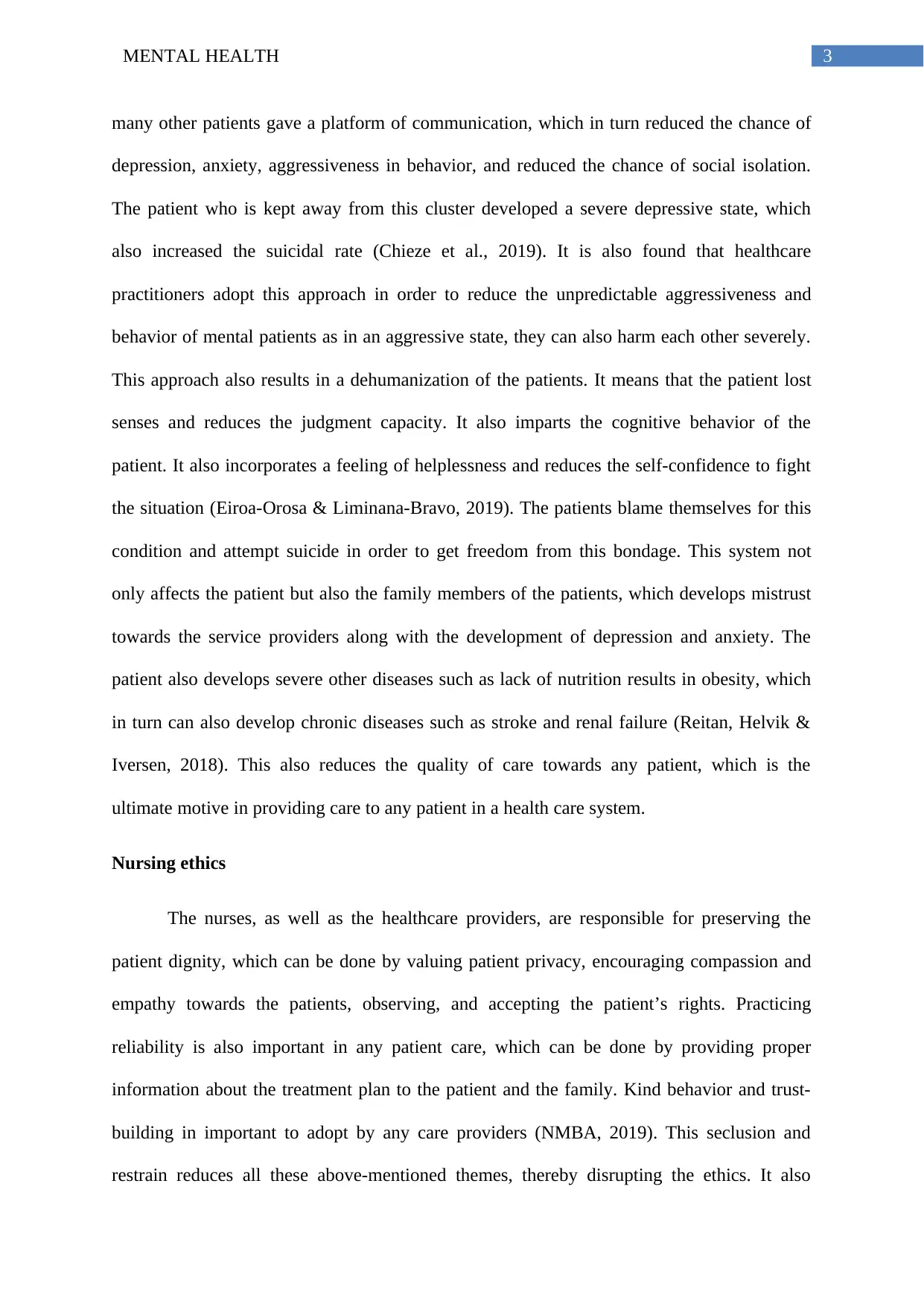
3MENTAL HEALTH
many other patients gave a platform of communication, which in turn reduced the chance of
depression, anxiety, aggressiveness in behavior, and reduced the chance of social isolation.
The patient who is kept away from this cluster developed a severe depressive state, which
also increased the suicidal rate (Chieze et al., 2019). It is also found that healthcare
practitioners adopt this approach in order to reduce the unpredictable aggressiveness and
behavior of mental patients as in an aggressive state, they can also harm each other severely.
This approach also results in a dehumanization of the patients. It means that the patient lost
senses and reduces the judgment capacity. It also imparts the cognitive behavior of the
patient. It also incorporates a feeling of helplessness and reduces the self-confidence to fight
the situation (Eiroa-Orosa & Liminana-Bravo, 2019). The patients blame themselves for this
condition and attempt suicide in order to get freedom from this bondage. This system not
only affects the patient but also the family members of the patients, which develops mistrust
towards the service providers along with the development of depression and anxiety. The
patient also develops severe other diseases such as lack of nutrition results in obesity, which
in turn can also develop chronic diseases such as stroke and renal failure (Reitan, Helvik &
Iversen, 2018). This also reduces the quality of care towards any patient, which is the
ultimate motive in providing care to any patient in a health care system.
Nursing ethics
The nurses, as well as the healthcare providers, are responsible for preserving the
patient dignity, which can be done by valuing patient privacy, encouraging compassion and
empathy towards the patients, observing, and accepting the patient’s rights. Practicing
reliability is also important in any patient care, which can be done by providing proper
information about the treatment plan to the patient and the family. Kind behavior and trust-
building in important to adopt by any care providers (NMBA, 2019). This seclusion and
restrain reduces all these above-mentioned themes, thereby disrupting the ethics. It also
many other patients gave a platform of communication, which in turn reduced the chance of
depression, anxiety, aggressiveness in behavior, and reduced the chance of social isolation.
The patient who is kept away from this cluster developed a severe depressive state, which
also increased the suicidal rate (Chieze et al., 2019). It is also found that healthcare
practitioners adopt this approach in order to reduce the unpredictable aggressiveness and
behavior of mental patients as in an aggressive state, they can also harm each other severely.
This approach also results in a dehumanization of the patients. It means that the patient lost
senses and reduces the judgment capacity. It also imparts the cognitive behavior of the
patient. It also incorporates a feeling of helplessness and reduces the self-confidence to fight
the situation (Eiroa-Orosa & Liminana-Bravo, 2019). The patients blame themselves for this
condition and attempt suicide in order to get freedom from this bondage. This system not
only affects the patient but also the family members of the patients, which develops mistrust
towards the service providers along with the development of depression and anxiety. The
patient also develops severe other diseases such as lack of nutrition results in obesity, which
in turn can also develop chronic diseases such as stroke and renal failure (Reitan, Helvik &
Iversen, 2018). This also reduces the quality of care towards any patient, which is the
ultimate motive in providing care to any patient in a health care system.
Nursing ethics
The nurses, as well as the healthcare providers, are responsible for preserving the
patient dignity, which can be done by valuing patient privacy, encouraging compassion and
empathy towards the patients, observing, and accepting the patient’s rights. Practicing
reliability is also important in any patient care, which can be done by providing proper
information about the treatment plan to the patient and the family. Kind behavior and trust-
building in important to adopt by any care providers (NMBA, 2019). This seclusion and
restrain reduces all these above-mentioned themes, thereby disrupting the ethics. It also
Paraphrase This Document
Need a fresh take? Get an instant paraphrase of this document with our AI Paraphraser
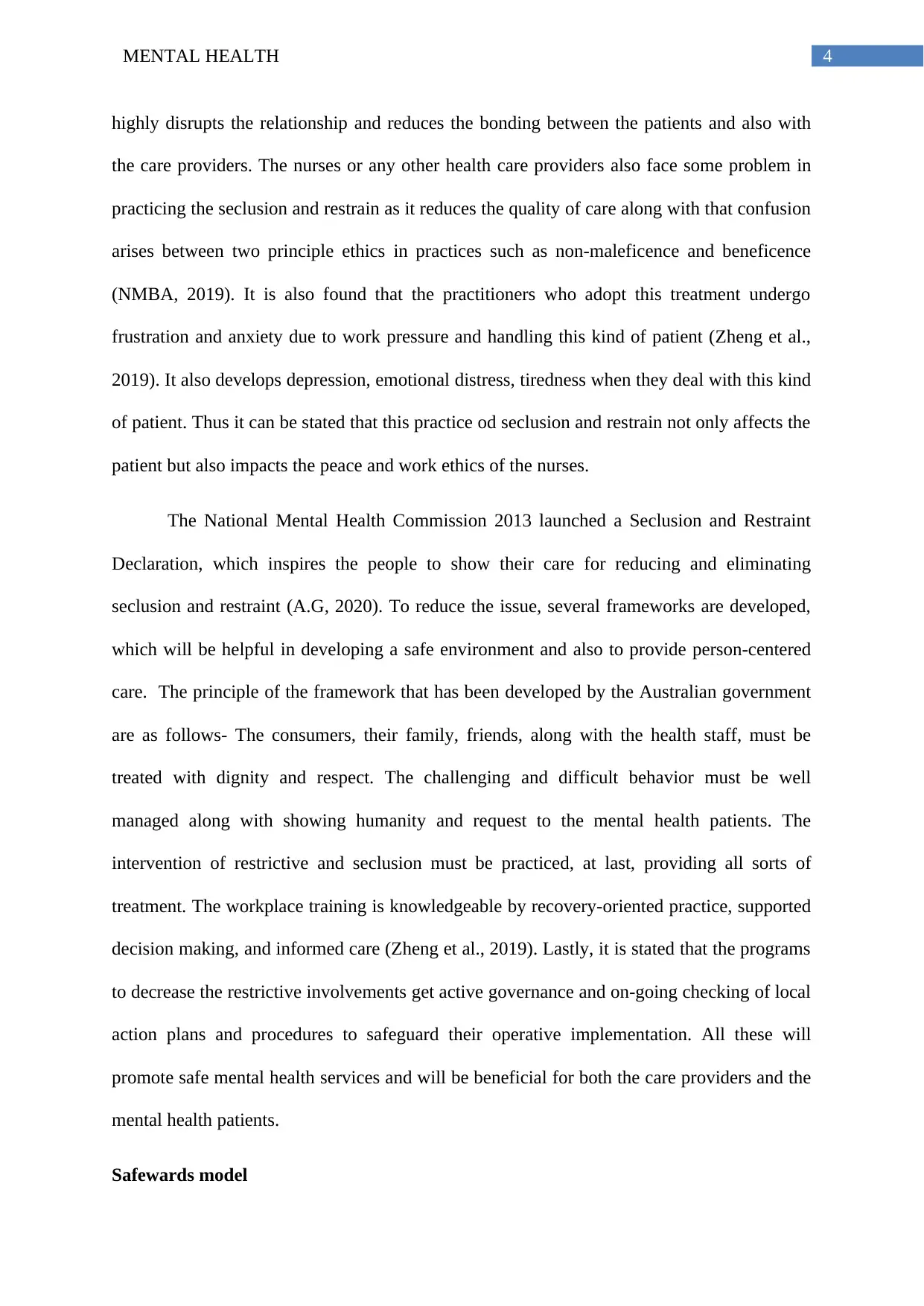
4MENTAL HEALTH
highly disrupts the relationship and reduces the bonding between the patients and also with
the care providers. The nurses or any other health care providers also face some problem in
practicing the seclusion and restrain as it reduces the quality of care along with that confusion
arises between two principle ethics in practices such as non-maleficence and beneficence
(NMBA, 2019). It is also found that the practitioners who adopt this treatment undergo
frustration and anxiety due to work pressure and handling this kind of patient (Zheng et al.,
2019). It also develops depression, emotional distress, tiredness when they deal with this kind
of patient. Thus it can be stated that this practice od seclusion and restrain not only affects the
patient but also impacts the peace and work ethics of the nurses.
The National Mental Health Commission 2013 launched a Seclusion and Restraint
Declaration, which inspires the people to show their care for reducing and eliminating
seclusion and restraint (A.G, 2020). To reduce the issue, several frameworks are developed,
which will be helpful in developing a safe environment and also to provide person-centered
care. The principle of the framework that has been developed by the Australian government
are as follows- The consumers, their family, friends, along with the health staff, must be
treated with dignity and respect. The challenging and difficult behavior must be well
managed along with showing humanity and request to the mental health patients. The
intervention of restrictive and seclusion must be practiced, at last, providing all sorts of
treatment. The workplace training is knowledgeable by recovery-oriented practice, supported
decision making, and informed care (Zheng et al., 2019). Lastly, it is stated that the programs
to decrease the restrictive involvements get active governance and on-going checking of local
action plans and procedures to safeguard their operative implementation. All these will
promote safe mental health services and will be beneficial for both the care providers and the
mental health patients.
Safewards model
highly disrupts the relationship and reduces the bonding between the patients and also with
the care providers. The nurses or any other health care providers also face some problem in
practicing the seclusion and restrain as it reduces the quality of care along with that confusion
arises between two principle ethics in practices such as non-maleficence and beneficence
(NMBA, 2019). It is also found that the practitioners who adopt this treatment undergo
frustration and anxiety due to work pressure and handling this kind of patient (Zheng et al.,
2019). It also develops depression, emotional distress, tiredness when they deal with this kind
of patient. Thus it can be stated that this practice od seclusion and restrain not only affects the
patient but also impacts the peace and work ethics of the nurses.
The National Mental Health Commission 2013 launched a Seclusion and Restraint
Declaration, which inspires the people to show their care for reducing and eliminating
seclusion and restraint (A.G, 2020). To reduce the issue, several frameworks are developed,
which will be helpful in developing a safe environment and also to provide person-centered
care. The principle of the framework that has been developed by the Australian government
are as follows- The consumers, their family, friends, along with the health staff, must be
treated with dignity and respect. The challenging and difficult behavior must be well
managed along with showing humanity and request to the mental health patients. The
intervention of restrictive and seclusion must be practiced, at last, providing all sorts of
treatment. The workplace training is knowledgeable by recovery-oriented practice, supported
decision making, and informed care (Zheng et al., 2019). Lastly, it is stated that the programs
to decrease the restrictive involvements get active governance and on-going checking of local
action plans and procedures to safeguard their operative implementation. All these will
promote safe mental health services and will be beneficial for both the care providers and the
mental health patients.
Safewards model
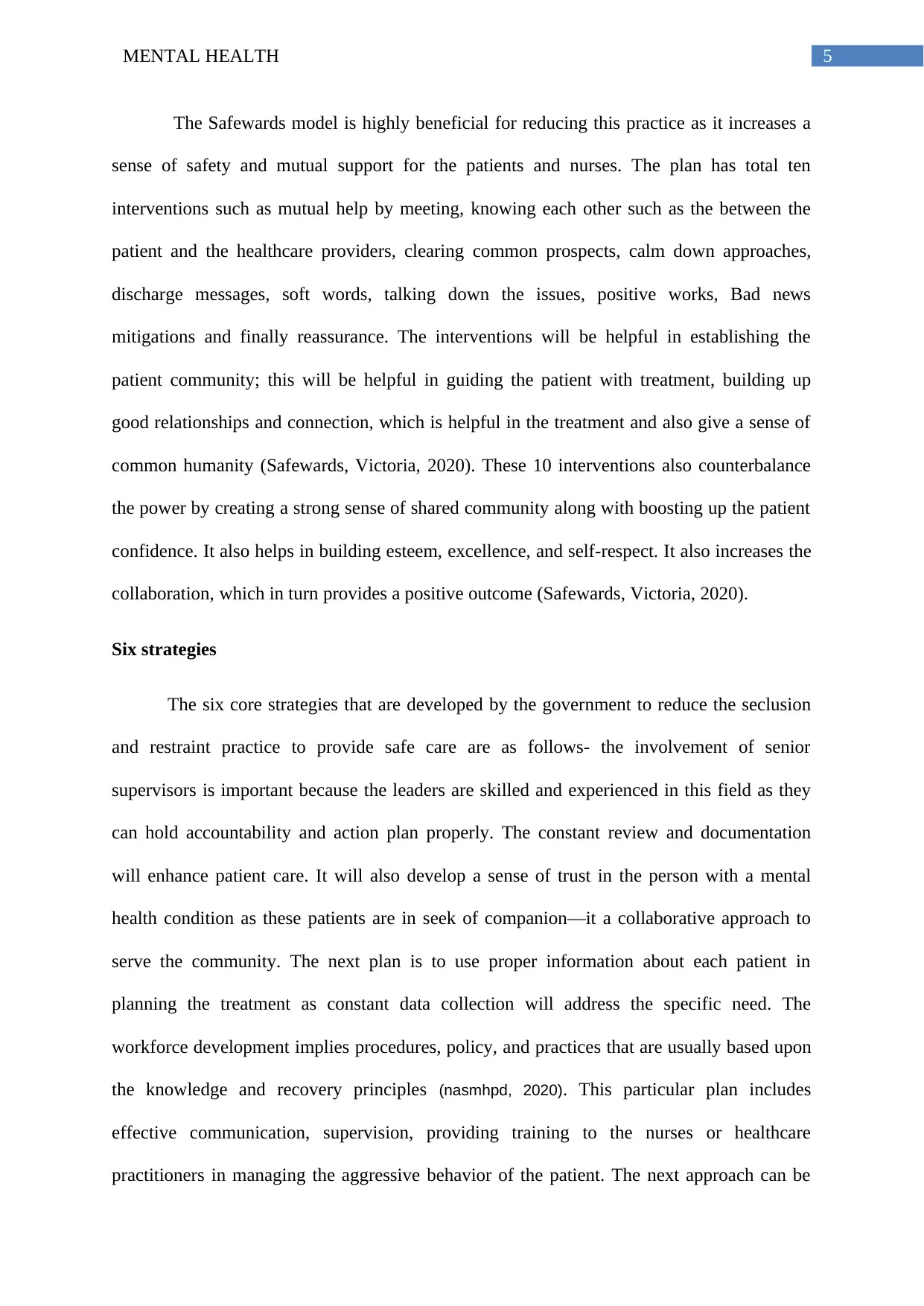
5MENTAL HEALTH
The Safewards model is highly beneficial for reducing this practice as it increases a
sense of safety and mutual support for the patients and nurses. The plan has total ten
interventions such as mutual help by meeting, knowing each other such as the between the
patient and the healthcare providers, clearing common prospects, calm down approaches,
discharge messages, soft words, talking down the issues, positive works, Bad news
mitigations and finally reassurance. The interventions will be helpful in establishing the
patient community; this will be helpful in guiding the patient with treatment, building up
good relationships and connection, which is helpful in the treatment and also give a sense of
common humanity (Safewards, Victoria, 2020). These 10 interventions also counterbalance
the power by creating a strong sense of shared community along with boosting up the patient
confidence. It also helps in building esteem, excellence, and self-respect. It also increases the
collaboration, which in turn provides a positive outcome (Safewards, Victoria, 2020).
Six strategies
The six core strategies that are developed by the government to reduce the seclusion
and restraint practice to provide safe care are as follows- the involvement of senior
supervisors is important because the leaders are skilled and experienced in this field as they
can hold accountability and action plan properly. The constant review and documentation
will enhance patient care. It will also develop a sense of trust in the person with a mental
health condition as these patients are in seek of companion—it a collaborative approach to
serve the community. The next plan is to use proper information about each patient in
planning the treatment as constant data collection will address the specific need. The
workforce development implies procedures, policy, and practices that are usually based upon
the knowledge and recovery principles (nasmhpd, 2020). This particular plan includes
effective communication, supervision, providing training to the nurses or healthcare
practitioners in managing the aggressive behavior of the patient. The next approach can be
The Safewards model is highly beneficial for reducing this practice as it increases a
sense of safety and mutual support for the patients and nurses. The plan has total ten
interventions such as mutual help by meeting, knowing each other such as the between the
patient and the healthcare providers, clearing common prospects, calm down approaches,
discharge messages, soft words, talking down the issues, positive works, Bad news
mitigations and finally reassurance. The interventions will be helpful in establishing the
patient community; this will be helpful in guiding the patient with treatment, building up
good relationships and connection, which is helpful in the treatment and also give a sense of
common humanity (Safewards, Victoria, 2020). These 10 interventions also counterbalance
the power by creating a strong sense of shared community along with boosting up the patient
confidence. It also helps in building esteem, excellence, and self-respect. It also increases the
collaboration, which in turn provides a positive outcome (Safewards, Victoria, 2020).
Six strategies
The six core strategies that are developed by the government to reduce the seclusion
and restraint practice to provide safe care are as follows- the involvement of senior
supervisors is important because the leaders are skilled and experienced in this field as they
can hold accountability and action plan properly. The constant review and documentation
will enhance patient care. It will also develop a sense of trust in the person with a mental
health condition as these patients are in seek of companion—it a collaborative approach to
serve the community. The next plan is to use proper information about each patient in
planning the treatment as constant data collection will address the specific need. The
workforce development implies procedures, policy, and practices that are usually based upon
the knowledge and recovery principles (nasmhpd, 2020). This particular plan includes
effective communication, supervision, providing training to the nurses or healthcare
practitioners in managing the aggressive behavior of the patient. The next approach can be
⊘ This is a preview!⊘
Do you want full access?
Subscribe today to unlock all pages.

Trusted by 1+ million students worldwide
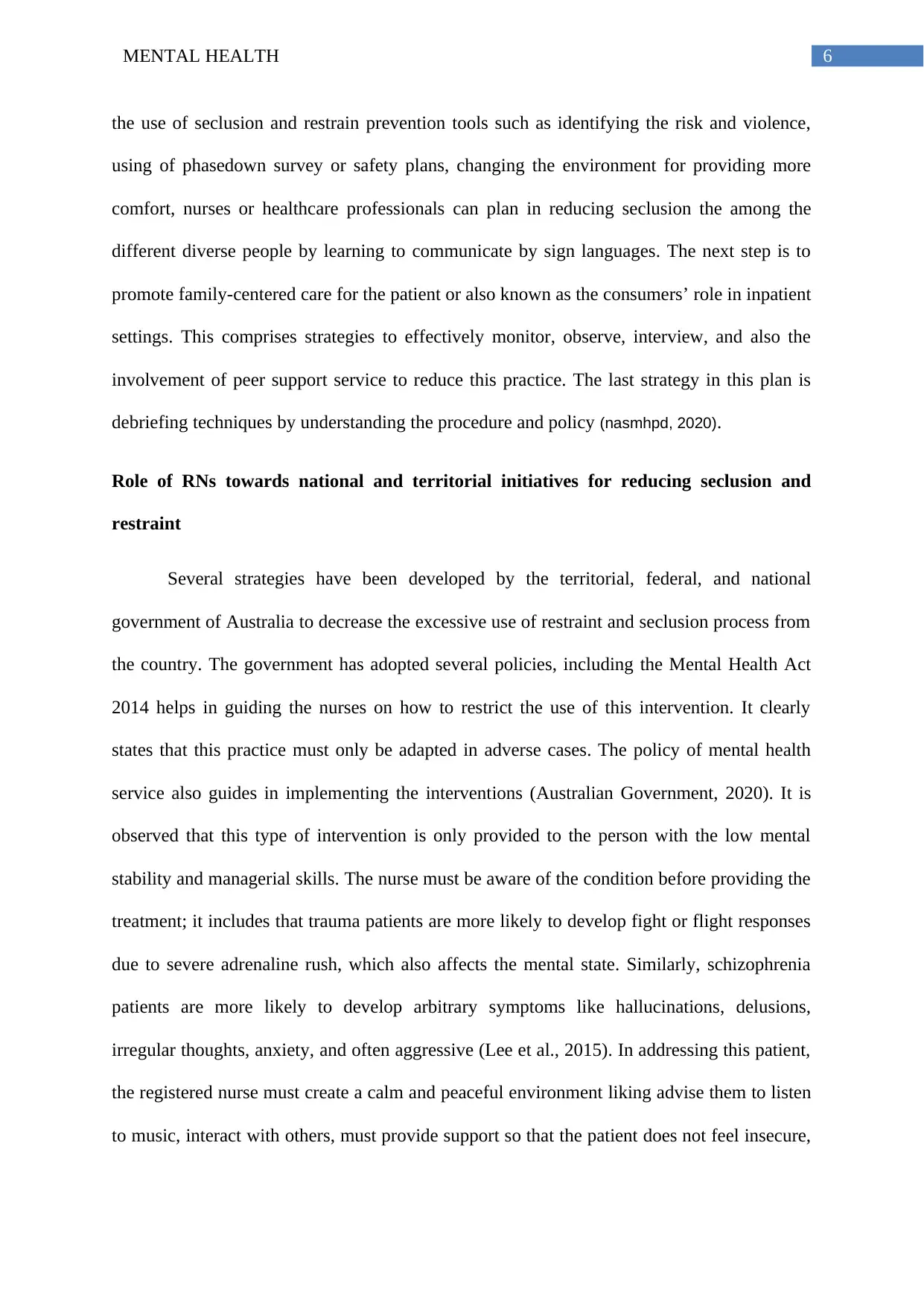
6MENTAL HEALTH
the use of seclusion and restrain prevention tools such as identifying the risk and violence,
using of phasedown survey or safety plans, changing the environment for providing more
comfort, nurses or healthcare professionals can plan in reducing seclusion the among the
different diverse people by learning to communicate by sign languages. The next step is to
promote family-centered care for the patient or also known as the consumers’ role in inpatient
settings. This comprises strategies to effectively monitor, observe, interview, and also the
involvement of peer support service to reduce this practice. The last strategy in this plan is
debriefing techniques by understanding the procedure and policy (nasmhpd, 2020).
Role of RNs towards national and territorial initiatives for reducing seclusion and
restraint
Several strategies have been developed by the territorial, federal, and national
government of Australia to decrease the excessive use of restraint and seclusion process from
the country. The government has adopted several policies, including the Mental Health Act
2014 helps in guiding the nurses on how to restrict the use of this intervention. It clearly
states that this practice must only be adapted in adverse cases. The policy of mental health
service also guides in implementing the interventions (Australian Government, 2020). It is
observed that this type of intervention is only provided to the person with the low mental
stability and managerial skills. The nurse must be aware of the condition before providing the
treatment; it includes that trauma patients are more likely to develop fight or flight responses
due to severe adrenaline rush, which also affects the mental state. Similarly, schizophrenia
patients are more likely to develop arbitrary symptoms like hallucinations, delusions,
irregular thoughts, anxiety, and often aggressive (Lee et al., 2015). In addressing this patient,
the registered nurse must create a calm and peaceful environment liking advise them to listen
to music, interact with others, must provide support so that the patient does not feel insecure,
the use of seclusion and restrain prevention tools such as identifying the risk and violence,
using of phasedown survey or safety plans, changing the environment for providing more
comfort, nurses or healthcare professionals can plan in reducing seclusion the among the
different diverse people by learning to communicate by sign languages. The next step is to
promote family-centered care for the patient or also known as the consumers’ role in inpatient
settings. This comprises strategies to effectively monitor, observe, interview, and also the
involvement of peer support service to reduce this practice. The last strategy in this plan is
debriefing techniques by understanding the procedure and policy (nasmhpd, 2020).
Role of RNs towards national and territorial initiatives for reducing seclusion and
restraint
Several strategies have been developed by the territorial, federal, and national
government of Australia to decrease the excessive use of restraint and seclusion process from
the country. The government has adopted several policies, including the Mental Health Act
2014 helps in guiding the nurses on how to restrict the use of this intervention. It clearly
states that this practice must only be adapted in adverse cases. The policy of mental health
service also guides in implementing the interventions (Australian Government, 2020). It is
observed that this type of intervention is only provided to the person with the low mental
stability and managerial skills. The nurse must be aware of the condition before providing the
treatment; it includes that trauma patients are more likely to develop fight or flight responses
due to severe adrenaline rush, which also affects the mental state. Similarly, schizophrenia
patients are more likely to develop arbitrary symptoms like hallucinations, delusions,
irregular thoughts, anxiety, and often aggressive (Lee et al., 2015). In addressing this patient,
the registered nurse must create a calm and peaceful environment liking advise them to listen
to music, interact with others, must provide support so that the patient does not feel insecure,
Paraphrase This Document
Need a fresh take? Get an instant paraphrase of this document with our AI Paraphraser
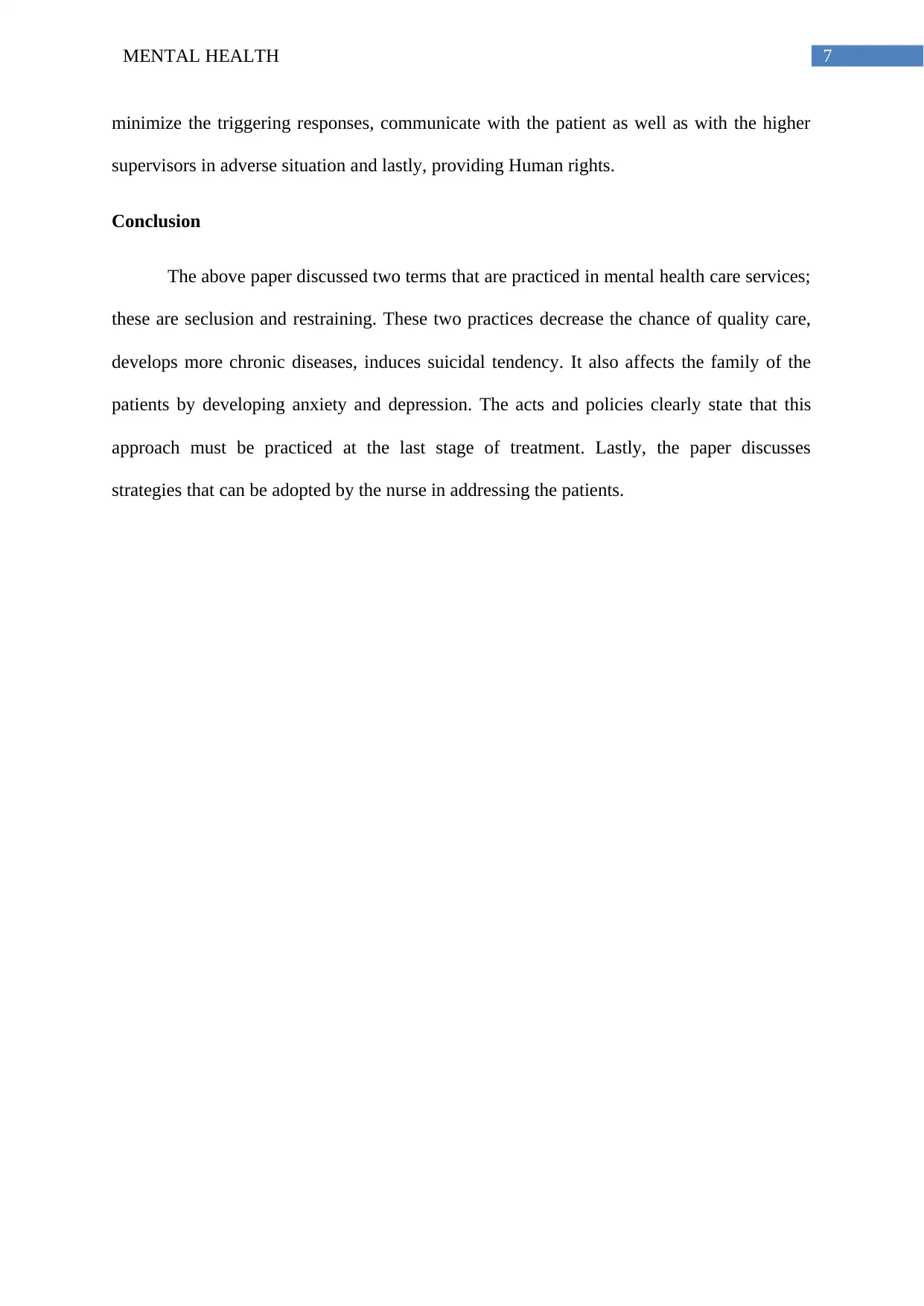
7MENTAL HEALTH
minimize the triggering responses, communicate with the patient as well as with the higher
supervisors in adverse situation and lastly, providing Human rights.
Conclusion
The above paper discussed two terms that are practiced in mental health care services;
these are seclusion and restraining. These two practices decrease the chance of quality care,
develops more chronic diseases, induces suicidal tendency. It also affects the family of the
patients by developing anxiety and depression. The acts and policies clearly state that this
approach must be practiced at the last stage of treatment. Lastly, the paper discusses
strategies that can be adopted by the nurse in addressing the patients.
minimize the triggering responses, communicate with the patient as well as with the higher
supervisors in adverse situation and lastly, providing Human rights.
Conclusion
The above paper discussed two terms that are practiced in mental health care services;
these are seclusion and restraining. These two practices decrease the chance of quality care,
develops more chronic diseases, induces suicidal tendency. It also affects the family of the
patients by developing anxiety and depression. The acts and policies clearly state that this
approach must be practiced at the last stage of treatment. Lastly, the paper discusses
strategies that can be adopted by the nurse in addressing the patients.
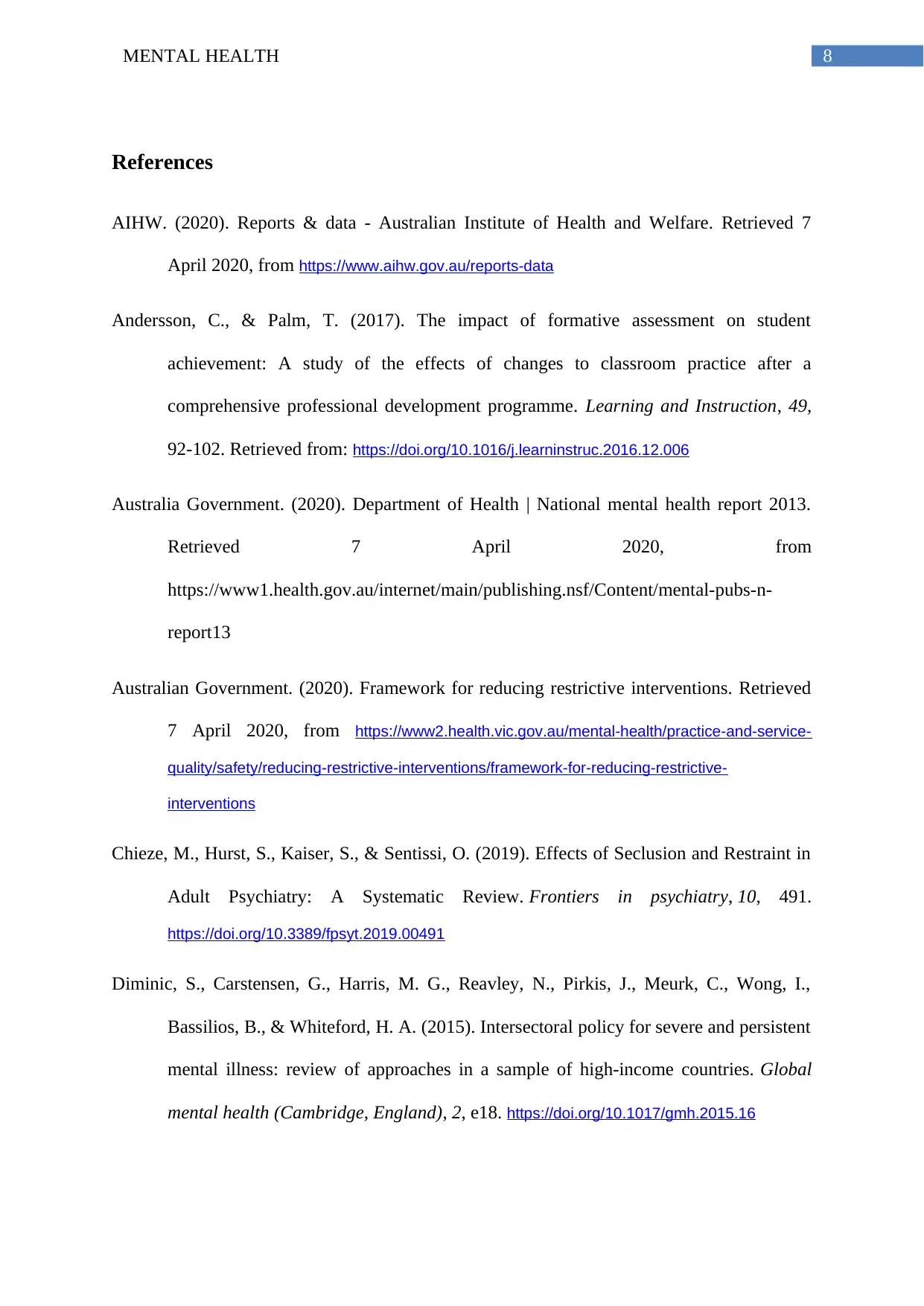
8MENTAL HEALTH
References
AIHW. (2020). Reports & data - Australian Institute of Health and Welfare. Retrieved 7
April 2020, from https://www.aihw.gov.au/reports-data
Andersson, C., & Palm, T. (2017). The impact of formative assessment on student
achievement: A study of the effects of changes to classroom practice after a
comprehensive professional development programme. Learning and Instruction, 49,
92-102. Retrieved from: https://doi.org/10.1016/j.learninstruc.2016.12.006
Australia Government. (2020). Department of Health | National mental health report 2013.
Retrieved 7 April 2020, from
https://www1.health.gov.au/internet/main/publishing.nsf/Content/mental-pubs-n-
report13
Australian Government. (2020). Framework for reducing restrictive interventions. Retrieved
7 April 2020, from https://www2.health.vic.gov.au/mental-health/practice-and-service-
quality/safety/reducing-restrictive-interventions/framework-for-reducing-restrictive-
interventions
Chieze, M., Hurst, S., Kaiser, S., & Sentissi, O. (2019). Effects of Seclusion and Restraint in
Adult Psychiatry: A Systematic Review. Frontiers in psychiatry, 10, 491.
https://doi.org/10.3389/fpsyt.2019.00491
Diminic, S., Carstensen, G., Harris, M. G., Reavley, N., Pirkis, J., Meurk, C., Wong, I.,
Bassilios, B., & Whiteford, H. A. (2015). Intersectoral policy for severe and persistent
mental illness: review of approaches in a sample of high-income countries. Global
mental health (Cambridge, England), 2, e18. https://doi.org/10.1017/gmh.2015.16
References
AIHW. (2020). Reports & data - Australian Institute of Health and Welfare. Retrieved 7
April 2020, from https://www.aihw.gov.au/reports-data
Andersson, C., & Palm, T. (2017). The impact of formative assessment on student
achievement: A study of the effects of changes to classroom practice after a
comprehensive professional development programme. Learning and Instruction, 49,
92-102. Retrieved from: https://doi.org/10.1016/j.learninstruc.2016.12.006
Australia Government. (2020). Department of Health | National mental health report 2013.
Retrieved 7 April 2020, from
https://www1.health.gov.au/internet/main/publishing.nsf/Content/mental-pubs-n-
report13
Australian Government. (2020). Framework for reducing restrictive interventions. Retrieved
7 April 2020, from https://www2.health.vic.gov.au/mental-health/practice-and-service-
quality/safety/reducing-restrictive-interventions/framework-for-reducing-restrictive-
interventions
Chieze, M., Hurst, S., Kaiser, S., & Sentissi, O. (2019). Effects of Seclusion and Restraint in
Adult Psychiatry: A Systematic Review. Frontiers in psychiatry, 10, 491.
https://doi.org/10.3389/fpsyt.2019.00491
Diminic, S., Carstensen, G., Harris, M. G., Reavley, N., Pirkis, J., Meurk, C., Wong, I.,
Bassilios, B., & Whiteford, H. A. (2015). Intersectoral policy for severe and persistent
mental illness: review of approaches in a sample of high-income countries. Global
mental health (Cambridge, England), 2, e18. https://doi.org/10.1017/gmh.2015.16
⊘ This is a preview!⊘
Do you want full access?
Subscribe today to unlock all pages.

Trusted by 1+ million students worldwide
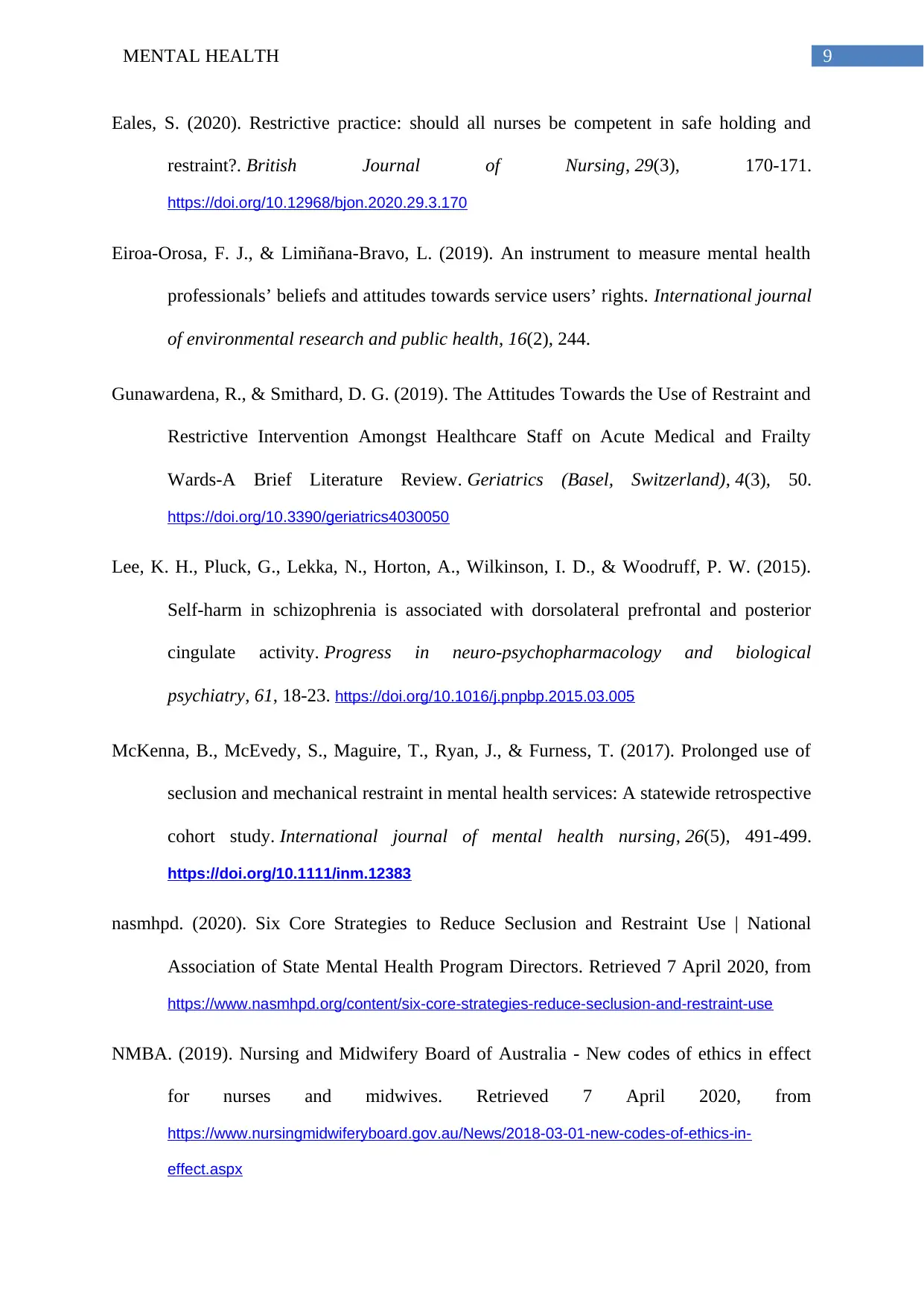
9MENTAL HEALTH
Eales, S. (2020). Restrictive practice: should all nurses be competent in safe holding and
restraint?. British Journal of Nursing, 29(3), 170-171.
https://doi.org/10.12968/bjon.2020.29.3.170
Eiroa-Orosa, F. J., & Limiñana-Bravo, L. (2019). An instrument to measure mental health
professionals’ beliefs and attitudes towards service users’ rights. International journal
of environmental research and public health, 16(2), 244.
Gunawardena, R., & Smithard, D. G. (2019). The Attitudes Towards the Use of Restraint and
Restrictive Intervention Amongst Healthcare Staff on Acute Medical and Frailty
Wards-A Brief Literature Review. Geriatrics (Basel, Switzerland), 4(3), 50.
https://doi.org/10.3390/geriatrics4030050
Lee, K. H., Pluck, G., Lekka, N., Horton, A., Wilkinson, I. D., & Woodruff, P. W. (2015).
Self-harm in schizophrenia is associated with dorsolateral prefrontal and posterior
cingulate activity. Progress in neuro-psychopharmacology and biological
psychiatry, 61, 18-23. https://doi.org/10.1016/j.pnpbp.2015.03.005
McKenna, B., McEvedy, S., Maguire, T., Ryan, J., & Furness, T. (2017). Prolonged use of
seclusion and mechanical restraint in mental health services: A statewide retrospective
cohort study. International journal of mental health nursing, 26(5), 491-499.
https://doi.org/10.1111/inm.12383
nasmhpd. (2020). Six Core Strategies to Reduce Seclusion and Restraint Use | National
Association of State Mental Health Program Directors. Retrieved 7 April 2020, from
https://www.nasmhpd.org/content/six-core-strategies-reduce-seclusion-and-restraint-use
NMBA. (2019). Nursing and Midwifery Board of Australia - New codes of ethics in effect
for nurses and midwives. Retrieved 7 April 2020, from
https://www.nursingmidwiferyboard.gov.au/News/2018-03-01-new-codes-of-ethics-in-
effect.aspx
Eales, S. (2020). Restrictive practice: should all nurses be competent in safe holding and
restraint?. British Journal of Nursing, 29(3), 170-171.
https://doi.org/10.12968/bjon.2020.29.3.170
Eiroa-Orosa, F. J., & Limiñana-Bravo, L. (2019). An instrument to measure mental health
professionals’ beliefs and attitudes towards service users’ rights. International journal
of environmental research and public health, 16(2), 244.
Gunawardena, R., & Smithard, D. G. (2019). The Attitudes Towards the Use of Restraint and
Restrictive Intervention Amongst Healthcare Staff on Acute Medical and Frailty
Wards-A Brief Literature Review. Geriatrics (Basel, Switzerland), 4(3), 50.
https://doi.org/10.3390/geriatrics4030050
Lee, K. H., Pluck, G., Lekka, N., Horton, A., Wilkinson, I. D., & Woodruff, P. W. (2015).
Self-harm in schizophrenia is associated with dorsolateral prefrontal and posterior
cingulate activity. Progress in neuro-psychopharmacology and biological
psychiatry, 61, 18-23. https://doi.org/10.1016/j.pnpbp.2015.03.005
McKenna, B., McEvedy, S., Maguire, T., Ryan, J., & Furness, T. (2017). Prolonged use of
seclusion and mechanical restraint in mental health services: A statewide retrospective
cohort study. International journal of mental health nursing, 26(5), 491-499.
https://doi.org/10.1111/inm.12383
nasmhpd. (2020). Six Core Strategies to Reduce Seclusion and Restraint Use | National
Association of State Mental Health Program Directors. Retrieved 7 April 2020, from
https://www.nasmhpd.org/content/six-core-strategies-reduce-seclusion-and-restraint-use
NMBA. (2019). Nursing and Midwifery Board of Australia - New codes of ethics in effect
for nurses and midwives. Retrieved 7 April 2020, from
https://www.nursingmidwiferyboard.gov.au/News/2018-03-01-new-codes-of-ethics-in-
effect.aspx
Paraphrase This Document
Need a fresh take? Get an instant paraphrase of this document with our AI Paraphraser
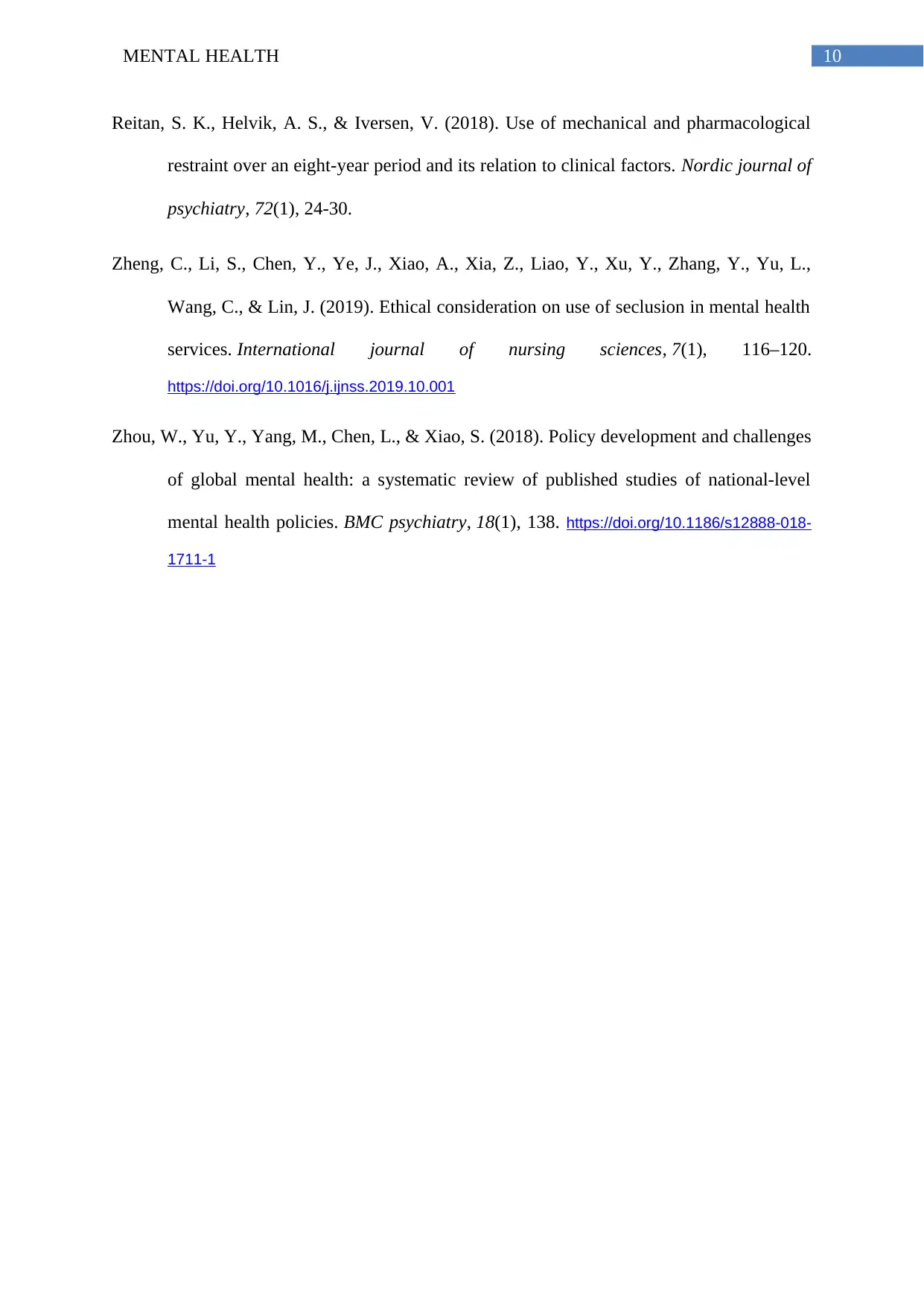
10MENTAL HEALTH
Reitan, S. K., Helvik, A. S., & Iversen, V. (2018). Use of mechanical and pharmacological
restraint over an eight-year period and its relation to clinical factors. Nordic journal of
psychiatry, 72(1), 24-30.
Zheng, C., Li, S., Chen, Y., Ye, J., Xiao, A., Xia, Z., Liao, Y., Xu, Y., Zhang, Y., Yu, L.,
Wang, C., & Lin, J. (2019). Ethical consideration on use of seclusion in mental health
services. International journal of nursing sciences, 7(1), 116–120.
https://doi.org/10.1016/j.ijnss.2019.10.001
Zhou, W., Yu, Y., Yang, M., Chen, L., & Xiao, S. (2018). Policy development and challenges
of global mental health: a systematic review of published studies of national-level
mental health policies. BMC psychiatry, 18(1), 138. https://doi.org/10.1186/s12888-018-
1711-1
Reitan, S. K., Helvik, A. S., & Iversen, V. (2018). Use of mechanical and pharmacological
restraint over an eight-year period and its relation to clinical factors. Nordic journal of
psychiatry, 72(1), 24-30.
Zheng, C., Li, S., Chen, Y., Ye, J., Xiao, A., Xia, Z., Liao, Y., Xu, Y., Zhang, Y., Yu, L.,
Wang, C., & Lin, J. (2019). Ethical consideration on use of seclusion in mental health
services. International journal of nursing sciences, 7(1), 116–120.
https://doi.org/10.1016/j.ijnss.2019.10.001
Zhou, W., Yu, Y., Yang, M., Chen, L., & Xiao, S. (2018). Policy development and challenges
of global mental health: a systematic review of published studies of national-level
mental health policies. BMC psychiatry, 18(1), 138. https://doi.org/10.1186/s12888-018-
1711-1
1 out of 11
Related Documents
Your All-in-One AI-Powered Toolkit for Academic Success.
+13062052269
info@desklib.com
Available 24*7 on WhatsApp / Email
![[object Object]](/_next/static/media/star-bottom.7253800d.svg)
Unlock your academic potential
Copyright © 2020–2025 A2Z Services. All Rights Reserved. Developed and managed by ZUCOL.





